 W
WThe Abacot Ranger is a breed of domestic duck, initially known as the Hooded Ranger and as Streicherente. A utility breed, originally developed for eggs and meat, it is popular for exhibition and egg production today.
 W
WThe African goose is a breed of domestic goose derived from the wild swan goose. Despite the name the African goose most likely originated in China, like the related Chinese goose. Though the African goose and Chinese goose share some characteristics, the two can be distinguished by the African's larger dewlap and different knob shape. African geese are also quite a bit heavier than Chinese, and are known for their docile temperament. Also, they lay fewer eggs than Chinese geese: 25 to 40 eggs per year for the African goose against 40 to 65, or, in extreme cases, up to 200 eggs per year for Chinese goose.
 W
WAlopochen is a genus of the bird family Anatidae, part of the subfamily Tadorninae along with the shelducks. It contains one extant species, the Egyptian goose, and two or three species which became extinct in the last 1000 years or so. The Egyptian goose is native to mainland Africa, and the extinct species are from Madagascar and the Mascarene Islands.
 W
WThe Alsatian goose, is a breed of goose developed in the French region of Alsace. A small breed, this goose was developed to grow a large and fatty liver for foie gras production.
 W
WThe Ancona is a breed of domestic duck, characterised by an unusual and variable broken-colored plumage pattern. It is not clear whether it originated in the United Kingdom or in the United States. It is not recognised or listed by the American Poultry Association, by the Entente Européenne d'Aviculture et de Cuniculture, or by the Poultry Club of Great Britain.
 W
WAnseranatidae, the magpie-geese, is a biological family of waterbirds. The only living species, the magpie goose, is a resident breeder in northern Australia and in southern New Guinea.
 W
WAythya is a genus of diving ducks. It has twelve described species. The name Aythya comes from the Ancient Greek word αυθυια, which may have referred to a sea-dwelling duck or an auklet.
 W
WBiziura is a genus of stiff-tailed ducks endemic to Australasia and containing one living and one subfossil species.
 W
WThe black brant or Pacific brent goose is a subspecies of the brant goose that breeds in Alaska and winters in Baja California. There are an estimated 115,000 black brant in the world and about 14,000 are taken each year by hunters. Fox predation of eggs is thought to be significant and, in 2006, the U.S. began a 5-year fox removal program. The population has been as high as 200,000 in 1981, and as low as 100,000 in 1987.
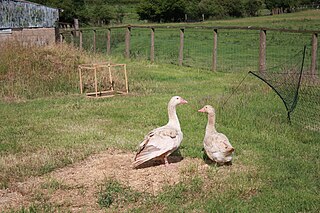 W
WThe Brecon Buff Goose is a breed of domestic goose originating in Wales.
 W
WBrewer's duck is an intergeneric hybrid between a mallard and a gadwall. John James Audubon painted a specimen, also referring to it as a Bemaculated Duck, a misspelling of "bimaculated".
 W
WThe white geese are a small group of waterfowl which are united in the genus or subgenus Chen, in the true geese and swan subfamily Anserinae. They breed on subarctic areas of North America and around the Bering Strait, migrating south in winter.
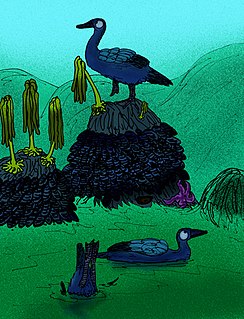 W
WChendytes lawi was a goose-sized flightless seaduck, once common on the California coast, the California Channel Islands, and possibly southern Oregon. It lived in the Pleistocene and survived into the Holocene. It appears to have gone extinct at about 450–250 BCE. IThe youngest direct radiocarbon date from a Chendytes bone fragment dates to 770–400 BCE and was found in an archeological site in Ventura County. Its remains have been found in fossil deposits and in early coastal archeological sites. Archeological data from coastal California show a record of human exploitation of Chendytes lawi for at least 8,000 years. It was probably driven to extinction by hunting, animal predation, and loss of habitat. Chendytes bones have been identified in archaeological assemblages from 14 coastal sites, including two on San Miguel Island and 12 in mainland localities. Hundreds of Chendytes bones and egg shells found in Pleistocene deposits on San Miguel Island have been interpreted as evidence that some of these island fossil localities were nesting colonies, one of which Guthrie dated to �12,000 14C years. There is nothing in the North American archaeological record indicating a span of exploitation for any megafaunal genus remotely as long as that of Chendytes.
 W
WThe Chinese goose is a breed of domesticated goose descended from the wild swan goose. Chinese geese differ from the wild birds in much larger size, and in having an often strongly developed basal knob on the upper side of the bill. The knob at the top of the beak is more prominent on males than females. It takes several months for the knob to become pronounced enough that it can be used for determining sex. Chinese geese are a close cousin of the African goose, a heavier breed also descended from the swan goose.
 W
WThe Cotton Patch is a breed of domestic goose originating in the Southern United States. It is so named because it traditionally was used to weed fields of cotton, corn, and other crops.
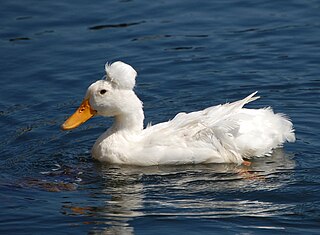 W
WThe Crested is a breed of domestic duck. It was probably brought to Europe from the East Indies by Dutch ships. It has its appearance because it is heterozygous for a genetic mutation causing a deformity of the skull.
 W
WCygnus falconeri, the giant swan, is an extinct, very large swan known from Middle Pleistocene-aged deposits from Malta and Sicily. Its dimensions are described as exceeding those of the living mute swan by one-third, which would give a bill-to-tail length of about 190–210 cm. By comparison to the bones of living swans, it can be estimated that it weighed around 16 kg and had a wingspan of about 3 m. It would have been taller, though not heavier, than the region's dwarf elephants. Due to its size, it may have been flightless. It became extinct before the increase in human activity in the region, so its disappearance is thought to have resulted from extreme climate fluctuations or the arrival of superior predators and competitors. Its bones are exhibited at Għar Dalam museum in Birżebbuġa Malta.
 W
WThe bronze-winged duck also known as the spectacled duck, is a dabbling duck and the sole member of its genus Speculanas. It is often placed in Anas with most other dabbling ducks, but its closest relative is either the crested duck or the Brazilian duck, which likewise form monotypic genera. Together they belong to a South American lineage which diverged early from the other dabbling ducks and may include the steamer ducks.
 W
WThe Andean crested duck is one of two subspecies of the crested duck. It is much rarer than its sibling subspecies, the Patagonian crested duck.
Hartlaub's duck is a dark chestnut-coloured duck of African forests. Formerly included in the paraphyletic "perching duck" assemblage, it was later moved to the dabbling duck assemblage. However, it is fairly distinct from the "typical" dabbling ducks, and is placed in the monotypic genus Pteronetta to reflect this.
 W
WThe Maccoa duck is a stiff-tailed diving duck found across Eastern and Southern Africa.
 W
WThe Philippine duck is a large dabbling duck of the genus Anas. Its native name is papan. It is endemic to the Philippines. As few as 5,000 may remain. Overhunting and habitat loss have contributed to its decline.
 W
WThe spotted whistling duck is a member of the duck family Anatidae.
 W
WThe Duclair duck is a dual purpose duck breed named after the town of Duclair in Normandy. It is a type of Rouen duck and is also described as being similar to the Swedish Blue. Official standards were established for the Duclair on November 23, 1923.
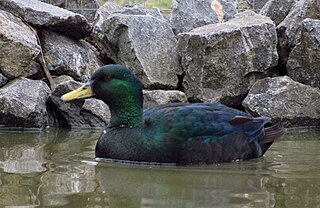 W
WThe East Indie or Black East Indian is an ornamental breed of domestic duck. It is a bantam breed, and is thought to have originated in the United States.
 W
WThe Falkland steamer duck is a steamer duck native to the Falkland Islands in the southern Atlantic Ocean. It is one of only two bird species endemic to the Falkland Islands, the other being Cobb's wren.
 W
WThe Golden Cascade is a breed of domestic duck developed in the United States. In 1979, David Holderread of Corvallis, Oregon set out to breed a duck that was fast growing, active, laid eggs well, and was auto-sexing. By the mid-1980s, the Golden Cascade was introduced to the market. It is not yet admitted to the American Poultry Association's Standard of Perfection.
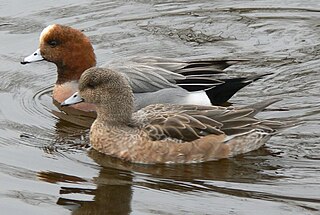 W
WMareca is a genus or subgenus of duck in the family Anatidae that includes the wigeons.
 W
WThe Mauritius sheldgoose, also known as the Mauritius shelduck, is an extinct species of goose from Mauritius.
 W
WThe Maui Nui large-billed moa-nalo, also known as the Maui Nui moa-nalo, is one of two species of moa-nalo in the genus Thambetochen. Moa-nalo are a group of extinct, flightless, large goose-like ducks, which evolved in the Hawaiian Islands of the North Pacific Ocean.
 W
WThe Oʻahu moa-nalo is one of two species of moa-nalo in the genus Thambetochen. Moa-nalo are a group of extinct, flightless, large goose-like ducks, which evolved in the Hawaiian Islands of the North Pacific Ocean.
 W
WThe small-billed moa-nalo, also known as the stumbling moa-nalo, is a species of moa-nalo, one of a group of extinct, flightless, large goose-like ducks, which evolved in the Hawaiian Islands of the North Pacific Ocean. It was described in 1991 from subfossil material collected in September 1982 by Storrs Olson, Helen James and others, from the Auwahi Cave on the southern slopes of Haleakalā, on the island of Maui.
 W
WThe turtle-jawed moa-nalo, also formerly referred to as the large Kauai goose, is a species of moa-nalo, one of a group of extinct, flightless, large goose-like ducks, which evolved in the Hawaiian Islands of the North Pacific Ocean. It was described in 1991 from subfossil material collected in 1976 by Storrs Olson from the calcareous Makawehi dunes on the south-eastern coast of the island of Kauai. Its remains have also been found at the nearby Makauwahi Cave site.
 W
WThe mulard is a hybrid between the different genera of domestic duck: the domestic muscovy and the domestic mallard. American Pekin are most commonly used to breed mulards due to the breed's high meat production. Like many interspecific F1 hybrids, mulards are sterile, giving them the nickname mule ducks. While it is possible to produce mulards naturally, artificial insemination is used more often with greater success.
 W
WNeochen is a genus of birds in the family Anatidae.
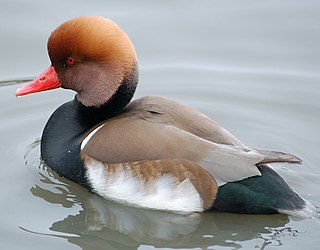 W
WNetta is a genus of diving ducks. The name is derived from Greek Netta "duck". Unlike other diving ducks, the Netta species are reluctant to dive, and feed more like dabbling ducks.
 W
WThe northern screamer, also known as the black-necked screamer, is a large species of bird in the small family Anhimidae, the screamers. It is a resident breeder in northern Colombia, in Chocó, Antioquia, Córdoba, Sucre, Bolívar, Magdalena, Santander, and Cesar Departments and northwestern Venezuela, in Zulia, Mérida, and Trujillo States. On average, they are 88.9 cm (35 in) long and weigh about 3.9 kg (8.6 lb).
 W
WThe Öland goose is a breed of domestic geese originating in Öland island in Sweden.
 W
WThe Orpington or Buff Orpington Duck is a breed of domestic duck. It is a dual-purpose breed used for meat and egg production. It is capable of laying up to 220 eggs a year. Originally created by William Cook of Orpington, Kent, UK, from the selection of mis-marked Blue Orpington Ducks; Cook was also the developer of the Orpington chicken. The breeds used in the development of the breed included Cayuga, Indian Runner, commercial Aylesbury and Rouen. It is purposed that Cook's intentions for the breed were to capitalize on the growing demand for the buff color pattern. The Buff Orpington Duck was introduced to the public at the Dairy Show, the Agricultural Hall (q.v.), Islington, London in October 1897. It is considered a threatened breed by the ALBC. This breed was admitted to the British Poultry Standard in 1910 and the American Poultry Associations Standard of Perfection as the 'Buff Duck' in the Medium class in 1914. The Orpington duck is available in three colour varieties: Buff, Blond and Brown. The Buff Orpington is an unstable colour due to a blue dilution gene which means that from the offspring, all three colour variations will appear.
 W
WEaton's pintail is a dabbling duck of the genus Anas. It is also known as the southern pintail. The species is restricted to the island groups of Kerguelen and Crozet in the southern Indian Ocean. It resembles a small female northern pintail. It was named after the English explorer and naturalist Alfred Edmund Eaton. It is threatened by introduced species, particularly feral cats, which prey on it.
 W
WThe southern pochard is a species of duck, and a member of the genus Netta. There are two subspecies, the South American (southern) pochard N. e. erythrophthalma and the African (southern) pochard N. e. brunnea.
 W
WThe Pomeranian or Pommern duck is a breed of domesticated duck. It is a landrace originating in the German part of the baltic sea coast region called Pomerania. Pomeranian ducks share the same ancestors with other northern European duck breeds, such as the Shetland duck and Swedish Blue duck.
 W
WThe Réunion shelduck or Kervazo's Egyptian goose is an extinct species of goose from Réunion. It was a close relative of the Egyptian goose and was about the same size. There is only one description remaining, that of Dubois made in 1674. He merely mentions that they were similar to European geese but smaller, with the bill and feet being red. Apart from that, the species is only known from brief reports and subfossil bones.
 W
WThe scoters are stocky seaducks in the genus Melanitta. The drakes are mostly black and have swollen bills. Females are brown. The genus name is derived from Ancient Greek melas "black" and netta "duck".
 W
WThe sheldgeese are a genus (Chloephaga) of birds in the family Anatidae.
 W
WThe Malagasy sheldgoose is an extinct monotypic species of large goose in the shelduck subfamily. It was described from subfossil remains radiocarbon dated to about 17,000 years ago, found in central Madagascar.
 W
WThe Malagasy shelduck, also known as the Sirabe shelduck, is an extinct species of waterfowl in the shelduck subfamily. It was described from subfossil bones found at Antsirabe in central Madagascar. Radiocarbon dating of subsequently discovered material shows that the bird survived to at least 1,400 years ago, after human settlement of the island. A close relative of the Egyptian goose, the bird is sometimes considered a subspecies of the extinct Mauritius sheldgoose; in this case it would become Alopochen maritiana sirabensis.
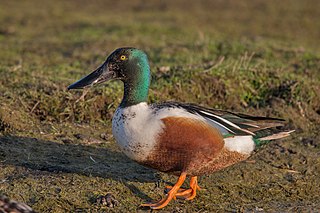 W
WSpatula is a genus or subgenus of ducks in the family Anatidae that includes the shovelers and some of the teals.
 W
WThe steamer ducks are a genus (Tachyeres) of ducks in the family Anatidae. All of the four species occur at the southern cone of South America in Chile and Argentina, and all except the flying steamer duck are flightless; even this one species capable of flight rarely takes to the air. The genus name Tachyeres, "having fast oars" or "fast rower", comes from Ancient Greek ταχυ- "fast" + ἐρέσσω "I row ". The common name "steamer ducks" arose because, when swimming fast, they flap their wings into the water as well as using their feet, creating an effect like a paddle steamer. They can be aggressive and are capable of chasing off predators like petrels. Bloody battles of steamer ducks with each other over territory disputes are observed in nature. They even kill waterbirds that are several times their size.
 W
WThe Puna teal is a species of dabbling duck in the family Anatidae. It was at one time regarded as a subspecies of the silver teal.
 W
WThe silver teal or versicolor teal is a species of dabbling duck in the genus Spatula. It breeds in South America.
 W
WThe Twente goose is a rare breed of domestic goose from the Twente region of the Netherlands.
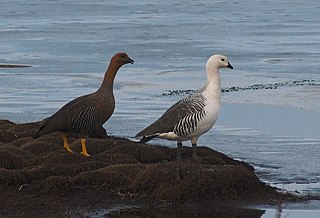 W
WThe upland goose or Magellan goose is a sheldgoose of the shelduck-sheldgoose subfamily of the Anatidae, the biological family that includes the ducks and most duck-like waterfowl such as the geese and swans. This bird is indigenous to the Falkland Islands which is located off of southern part of South America.
 W
WVictoria is the first goose to receive a prosthetic 3D printed beak. Victoria was found on the São Paulo coast in late 2015, without most of her beak. She was transferred to the care of the Friend of the Sea in collaboration with Animal Avengers, when Cícero Moraes was still part of the team. It is not clear how Victoria lost her beak. A 3D printed prosthetic beak was attached by veterinarians of the University of São Paulo.
 W
WThe Welsh Harlequin is a breed of domestic duck originating in Wales. In 1949, in Criccieth, Group Captain Leslie Bonnet discovered a colour mutation among his flock of Khaki Campbells and began selective breeding for the trait. By 1968, hatching eggs were exported to the United States, followed by the importation of live birds in 1981.
 W
WThe wigeons or widgeons are a group of birds, dabbling ducks currently classified in the genus Mareca along with two other species. There are three extant species of wigeon, in addition to one recently extinct species.